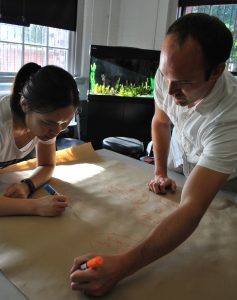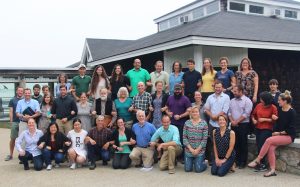Visualizing Collaboration
The Future of Dams project held an All-Team Meeting at the Rhode Island School of Design (RISD)—a partner institution on the project—at the end of September. Below, Mitchell Center team members, postdoctoral researcher Sam Roy and Ph.D. student Tyler Quiring, provide brief highlights from three of the meeting’s break-out groups— Model/Data Integration (Roy) and Collaborative Blogging and Stakeholder Engagement (Quiring).

The Model/Data Integration breakout session was designed to connect seamlessly with a previous group activity hosted by Emily Vogler at the RISD Nature Lab. Emily’s activity was focused on visualizing the collaborations between researchers in FoD, that is, building a map of different research interests/topics and showing how they link with one another to reach new levels of collaborative research.
Pursuing challenges in sustainability across many disciplines is a critical part of creating innovative, useful, and critically tested science, all of which are important if we hope to inform dam decisions with scientific knowledge. The model/data integration session drew upon the RISD mapping session to focus on specific plans for co-producing knowledge across multiple social-ecological research disciplines. This included:
- Detailed conversations about tightening collaborative ties between biophysical data collectors, social data collectors, and modelers. For example, team members Andrew Newcomb, Dave Simon, and Iman Shakib shared their biophysical modeling capabilities in order to find new avenues for collaboration;
- Conversations between various modelers and other researchers who are designing surveys to better understand how stakeholders value different benefits they received from rivers and dams in order to:
- a.) understand what common themes exist between the model types;
- b.) determine what unique information can be gathered by each method;
- c.) determine how to work together to get the most out of each model; and,
- d.) connect with data sources, biophysical models, and social models to improve the impact of our results.
- Where to go from here: plans for publications that are rising out of our conversations and shared work.
“I left the meeting confident that our group has never been so connected, on the same page with research goals, and motivated to get the work done,” Roy reports.

Collaborative Blogging is a student-led group that is focused on developing new ways of enhancing and sustaining collaboration through online storytelling tools. We have developed a blogging platform for developing our thinking about the work of sustainability science and are populating this platform with resources such as best practices for academic blogging, fact sheets for key dams and rivers in New England, key terms and definitions for sustainability science about dams, and links to relevant academic blogs and sustainability websites.
We are also building a foundation to populate this blog with regular writing, photos, and video content focused on Future of Dams team research, issues related to rivers and dams, and more broad recommendations for how to connect science with meaningful action.
During the All-Team meeting, we presented the beta version of our website to the full team (it’s not ready to be shared with the public quite yet) and engaged in a short Q&A period about possible refinements to the feature set and approach. We then had a dedicated breakout session focused on identifying next steps for the platform and content. Key questions include which features we need to focus on and enhance next, and more generally how we can ensure this approach is sustainable and useful for the public in the long term.
The Stakeholder Engagement Working Group is focused on identifying and building collaborative research connections among our research team to support and extend our work with key stakeholders and the public. For several months, we have been refining our approach through an innovative and integrated collaborative research design process that has set the stage for engaging stakeholder interviews with key informants.
Moving forward, a key focus of our group (and a primary topic for our discussion at the All-Team meeting breakout session) is further developing our internal team collaboration so that we can engage with stakeholders in purposeful and effective ways.
“We had a fantastic conversation and identified several areas where we can work toward these goals, including enhancing our use of Google Docs collaborative technologies and approaching our analysis in a coordinated way,” says Quiring.
